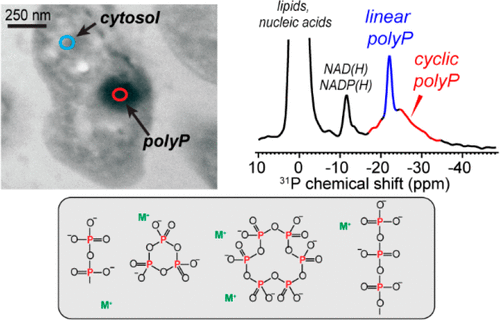当前位置:
X-MOL 学术
›
J. Am. Chem. Soc.
›
论文详情
Our official English website, www.x-mol.net, welcomes your
feedback! (Note: you will need to create a separate account there.)
Bacterial Phosphate Granules Contain Cyclic Polyphosphates: Evidence from 31P Solid-State NMR
Journal of the American Chemical Society ( IF 14.4 ) Pub Date : 2020-10-19 , DOI: 10.1021/jacs.0c06335 Venkata S Mandala 1 , Daniel M Loh 2 , Scott M Shepard 1 , Michael B Geeson 1 , Ivan V Sergeyev 3 , Daniel G Nocera 2 , Christopher C Cummins 1 , Mei Hong 1
Journal of the American Chemical Society ( IF 14.4 ) Pub Date : 2020-10-19 , DOI: 10.1021/jacs.0c06335 Venkata S Mandala 1 , Daniel M Loh 2 , Scott M Shepard 1 , Michael B Geeson 1 , Ivan V Sergeyev 3 , Daniel G Nocera 2 , Christopher C Cummins 1 , Mei Hong 1
Affiliation

|
Polyphosphates (polyPs) are ubiquitous polymers in living organisms from bacteria to mammals. They serve a wide variety of biological functions, ranging from energy storage to stress response. In the last two decades, polyPs have been primarily viewed as linear polymers with varying chain lengths. However, recent biochemical data show that small metaphosphates, cyclic oligomers of [PO3](-), can bind to the enzymes ribonuclease A and NAD kinase, raising the question of whether metaphosphates can occur naturally as products of biological activity. Before the 1980s, metaphosphates had been reported in polyPs extracted from various organisms, but these results are considered artifactual due to the extraction and purification protocols. Here, we employ nondestructive 31P solid-state NMR spectroscopy to investigate the chemical structure of polyphosphates in whole cells as well as insoluble fractions of the bacterium Xanthobacter autotrophicus. Isotropic and anisotropic 31P chemical shifts of hydrated whole cells indicate the coexistence of linear and cyclic phosphates. Under our cell growth conditions and the concentrated conditions of the solid-state NMR samples, we found substantial amounts of cyclic phosphates in X. autotrophicus, suggesting that in fresh cells metaphosphate concentrations can be significant. The cellular metaphosphates are identified by comparison with the 31P chemical shift anisotropy of synthetic metaphosphates of known structures. In X. autotrophicus, the metaphosphates have a chemical shift anisotropy that is consistent with an average size of 3-8 phosphate units. These metaphosphates are enriched in insoluble and electron-dense granules. Exogenous hexametaphosphate added to X. autotrophicus cell extracts is metabolized to trimetaphosphates, supporting the presence and biological role of metaphosphates in cells. The definitive evidence for the presence of metaphosphates, reported here in whole bacterial cells for the first time, opens the path for future investigations of the biological function of metaphosphates in many organisms.
中文翻译:

细菌磷酸盐颗粒含有环状多磷酸盐:来自 31P 固态 NMR 的证据
多磷酸盐 (polyPs) 是从细菌到哺乳动物的生物体中普遍存在的聚合物。它们具有广泛的生物学功能,从能量储存到压力反应。在过去的二十年中,polyPs 主要被视为具有不同链长的线性聚合物。然而,最近的生化数据表明,[PO3](-) 的环状低聚物小偏磷酸盐可以与酶核糖核酸酶 A 和 NAD 激酶结合,从而提出了偏磷酸盐是否可以作为生物活性产物天然存在的问题。在 1980 年代之前,已经报道了从各种生物体中提取的息肉中含有偏磷酸盐,但由于提取和纯化协议,这些结果被认为是人为的。这里,我们采用无损 31P 固态 NMR 光谱来研究全细胞中多磷酸盐的化学结构以及自养黄杆菌的不溶性部分。水合全细胞的各向同性和各向异性 31P 化学位移表明线性和环状磷酸盐共存。在我们的细胞生长条件和固态 NMR 样品的浓缩条件下,我们在自养 X. autotrophicus 中发现了大量的环状磷酸盐,这表明在新鲜细胞中偏磷酸盐浓度可能很高。通过与已知结构的合成偏磷酸盐的 31P 化学位移各向异性进行比较来鉴定细胞偏磷酸盐。在 X. autotrophicus 中,偏磷酸盐的化学位移各向异性与 3-8 个磷酸盐单位的平均大小一致。这些偏磷酸盐富含不溶性和电子致密的颗粒。添加到 X. autotrophicus 细胞提取物中的外源性六偏磷酸盐被代谢为三偏磷酸盐,支持偏磷酸盐在细胞中的存在和生物学作用。此处首次在整个细菌细胞中报道了偏磷酸盐存在的确切证据,为未来研究偏磷酸盐在许多生物体中的生物学功能开辟了道路。
更新日期:2020-10-19
中文翻译:

细菌磷酸盐颗粒含有环状多磷酸盐:来自 31P 固态 NMR 的证据
多磷酸盐 (polyPs) 是从细菌到哺乳动物的生物体中普遍存在的聚合物。它们具有广泛的生物学功能,从能量储存到压力反应。在过去的二十年中,polyPs 主要被视为具有不同链长的线性聚合物。然而,最近的生化数据表明,[PO3](-) 的环状低聚物小偏磷酸盐可以与酶核糖核酸酶 A 和 NAD 激酶结合,从而提出了偏磷酸盐是否可以作为生物活性产物天然存在的问题。在 1980 年代之前,已经报道了从各种生物体中提取的息肉中含有偏磷酸盐,但由于提取和纯化协议,这些结果被认为是人为的。这里,我们采用无损 31P 固态 NMR 光谱来研究全细胞中多磷酸盐的化学结构以及自养黄杆菌的不溶性部分。水合全细胞的各向同性和各向异性 31P 化学位移表明线性和环状磷酸盐共存。在我们的细胞生长条件和固态 NMR 样品的浓缩条件下,我们在自养 X. autotrophicus 中发现了大量的环状磷酸盐,这表明在新鲜细胞中偏磷酸盐浓度可能很高。通过与已知结构的合成偏磷酸盐的 31P 化学位移各向异性进行比较来鉴定细胞偏磷酸盐。在 X. autotrophicus 中,偏磷酸盐的化学位移各向异性与 3-8 个磷酸盐单位的平均大小一致。这些偏磷酸盐富含不溶性和电子致密的颗粒。添加到 X. autotrophicus 细胞提取物中的外源性六偏磷酸盐被代谢为三偏磷酸盐,支持偏磷酸盐在细胞中的存在和生物学作用。此处首次在整个细菌细胞中报道了偏磷酸盐存在的确切证据,为未来研究偏磷酸盐在许多生物体中的生物学功能开辟了道路。











































 京公网安备 11010802027423号
京公网安备 11010802027423号